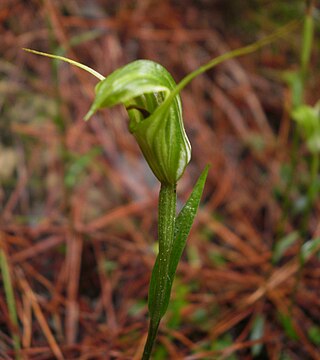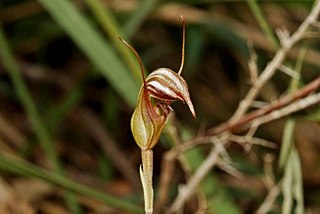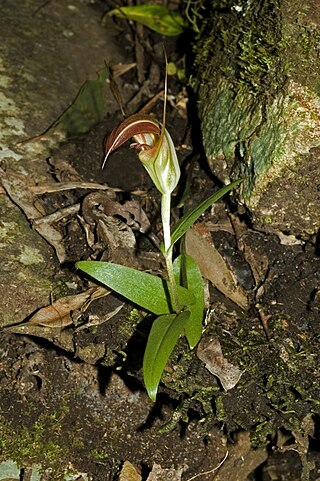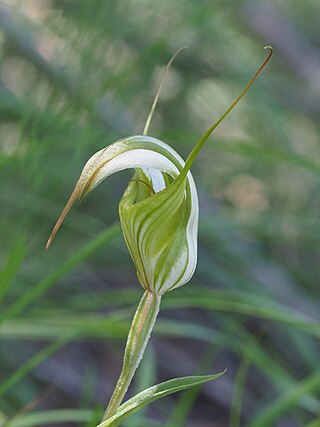
Pterostylis trullifolia, commonly known as the trowel-leaved greenhood, is an orchid species endemic to New Zealand. As with similar orchids, the flowering plants differ from those which are not flowering. The non-flowering plants have a rosette of wrinkled, trowel-shaped leaves but the flowering plants have a single flower with a bulging, platform-like sinus between the lateral sepals and leaves on the flowering spike.

Pterostylis banksii, commonly known as greenhood or tutukiwi, is a species of orchid endemic to New Zealand. Non-flowering plants have a rosette of leaves. Flowering plants have leaves on the flowering stem, some of which reach above the single relatively large, green flower with translucent white stripes. It is the most common, widespread and largest New Zealand greenhood and is found on both of the main islands.

Pterostylis robusta, commonly known as the sharp-leaf greenhood, is a species of orchid endemic to south-eastern Australia. As with similar orchids, the flowering plants differ from those which are not flowering. The non-flowering plants have a rosette of leaves but the flowering plants have a single flower with leaves on the flowering spike. This greenhood has a relatively large green, white and reddish-brown flower with reddish-brown stripes with the labellum just visible inside the flower.

Pterostylis squamata, commonly known as the southern rustyhood or ruddyhood, is a plant in the orchid family Orchidaceae and is endemic to south-eastern Australia. Flowering plants have up to ten translucent green flowers with reddish-brown markings and a hairy, insect-like labellum. Non-flowering plants have a rosette of four to eight egg-shaped leaves. This species is very similar to Pterostylis rufa which has a narrower labellum and other minor differences.

Pterostylis woollsii, commonly known as the long-tailed rustyhood, is a plant in the orchid family Orchidaceae and is endemic to eastern Australia. It has a rosette of leaves at its base and up to six transparent flowers which have unusually long tips on their lateral sepals and a reddish-brown, insect-like labellum.

Pterostylis longipetala, commonly known as the curved greenhood, is a species of orchid endemic to eastern Australia. As with similar greenhoods, the flowering plants differ from those which are not flowering. The non-flowering plants have a rosette of leaves flat on the ground but the flowering plants have a single flower with leaves on the flowering spike. This greenhood has dark green, brown and white flowers which lean slightly forwards and have sharply-pointed petals and a long, curved labellum.

Pterostylis multiflora, commonly known as the tall tiny greenhood, is a species of orchid endemic to south-eastern Australia. As with similar orchids, plants in flower differ from those that are not. Those not in flower have a rosette of leaves lying flat on the ground. Plants in flower lack a rosette but have up to twenty tiny green, white, and brown flowers in summer. The flowering stem has up to six stem leaves.
Pterostylis aquilonia, commonly known as the northern cobra greenhood, is a species of orchid endemic to Queensland. As with similar orchids, the flowering plants differ from those which are not flowering. The non-flowering plants have a rosette of leaves, but the flowering plants lack a rosette and have a single flower with leaves on the flowering spike. This greenhood has a relatively large green, white and reddish-brown self-pollinating flower.
Pterostylis aspera, commonly known as the rough shell orchid, is a species of orchid endemic to the south-west of Western Australia. As with similar greenhoods, the flowering plants differ from those which are not flowering. The non-flowering plants have a rosette of leaves flat on the ground but the flowering plants have a single flower with leaves on the flowering spike. In this common species, the flower is white with green and reddish-brown stripes and a short, straight labellum.
Pterostylis cernua, commonly known as the Westland greenhood, is a species of orchid endemic to New Zealand. Non-flowering plants have a rosette of leaves but flowering plants have a single white, dark green and reddish-brown flower with leaves on the flowering stem.

Pterostylis collina, commonly known as the shiny bull orchid, is a species of orchid endemic to New South Wales. It has a rosette of leaves and when flowering, a single reddish-brown, green and white flower with a curved top.

Pterostylis elegans, commonly known as the elegant greenhood, is a species of orchid endemic to New South Wales. Non-flowering plants have a rosette of leaves flat on the ground but flowering plants have a single translucent white and dark green flower with reddish-brown markings near the tip.

Pterostylis humilis is a species of orchid endemic to New Zealand. It has a rosette of leaves at the base of the plant and when flowering stem, leaves which usually obscure the dark green and white flower.

Pterostylis pulchella, commonly known as the waterfall greenhood, escarpment greenhood or pretty greenhood is a species of orchid endemic to New South Wales. As with similar greenhoods, the flowering plants differ from those that are not flowering. The non-flowering plants have a rosette of leaves flat on the ground but the flowering plants have a single flower with leaves on the flowering stem. This greenhood has a reddish-brown flower with a greenish-white base and protruding labellum with a cleft tip.

Pterostylis pusilla, commonly known as the tiny rustyhood is a plant in the orchid family Orchidaceae and is endemic to southern Australia. It has a rosette of leaves and up to nine relatively small green and reddish-brown flowers with translucent white "windows" and a dark brown, insect-like labellum.

Pterostylis reflexa, commonly known as the dainty greenhood, is a species of orchid endemic to New South Wales. As with similar greenhoods, the flowering plants differ from those which are not flowering. The non-flowering plants have a rosette of leaves flat on the ground but the flowering plants have a single flower with leaves on the flowering stem. This greenhood has a relatively large white, green and light brown flower with a long, curved dorsal sepal and a protruding labellum.
Pterostylis rogersii, commonly known as the curled-tongue shell orchid, is a species of orchid endemic to the south-west of Western Australia. As with similar orchids, the flowering plants differ from those which are not flowering. The non-flowering plants have a rosette of leaves but the flowering plants lack a rosette and have a single flower with leaves on the flowering spike. This greenhood usually has a white and reddish-brown striped flower with a long, curved labellum and is found along the south coast between Binningup and Esperance.

Pterostylis rufa, commonly known as the red rustyhood is a plant in the orchid family Orchidaceae and is endemic to south-eastern Australia. It has a rosette of leaves and up to fifteen bright reddish-brown flowers with translucent white "windows" and a dark brown, insect-like labellum. It occurs from southern Queensland to south-eastern South Australia.
Pterostylis scoliosa, commonly known as the small kinked greenhood, is a species of orchid endemic to Queensland. As with similar greenhoods, the flowering plants differ from those which are not flowering. The non-flowering plants have a rosette of leaves flat on the ground but the flowering plants have a single flower with leaves on the flowering stem. This greenhood has a white, pale green and pale brown flower with a kinked or curved labellum protruding above the sinus between the lateral sepals.
Pterostylis erubescens, commonly known as the red sepaled snail orchid, is a species of orchid endemic to the south-west of Western Australia. Non-flowering plants have a rosette of leaves flat on the ground but flowering plants lack a rosette and have a single large green flower which turns reddish-brown as it ages, and has leaves on the flowering spike.













